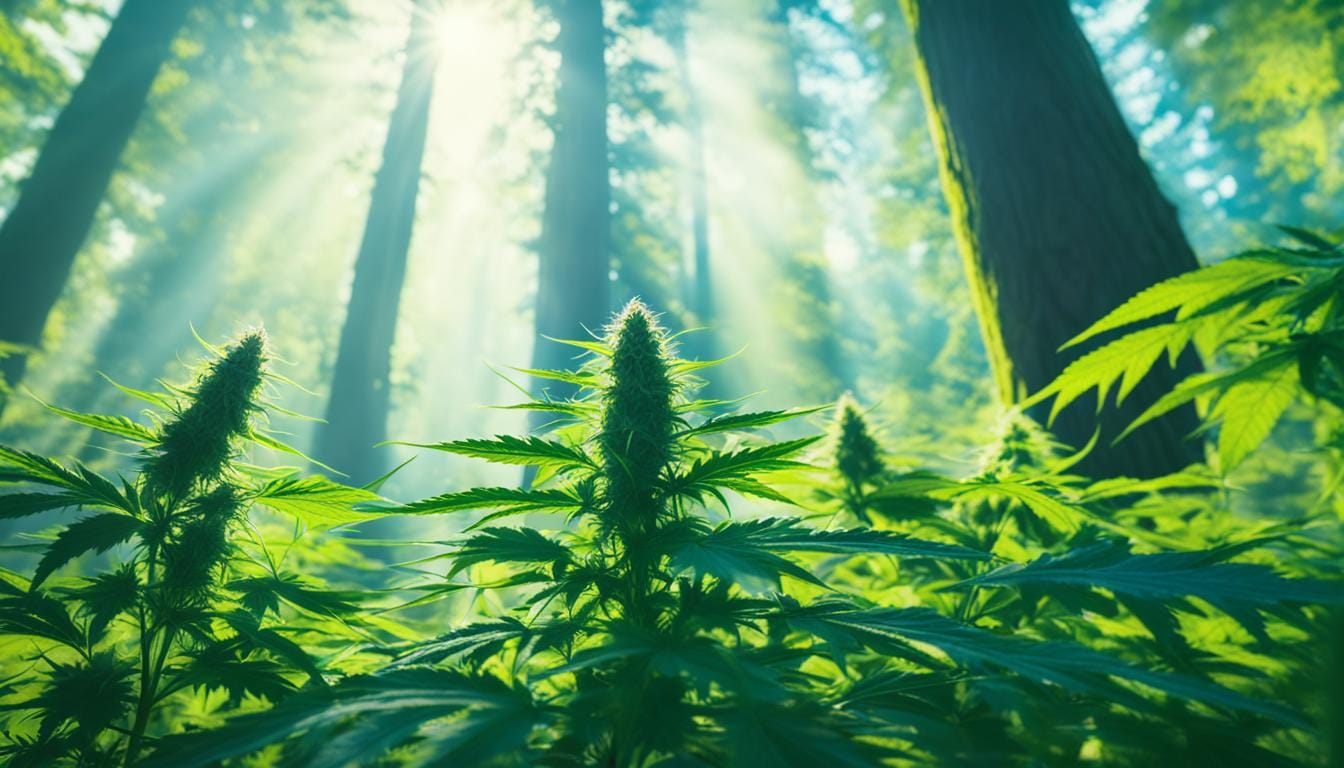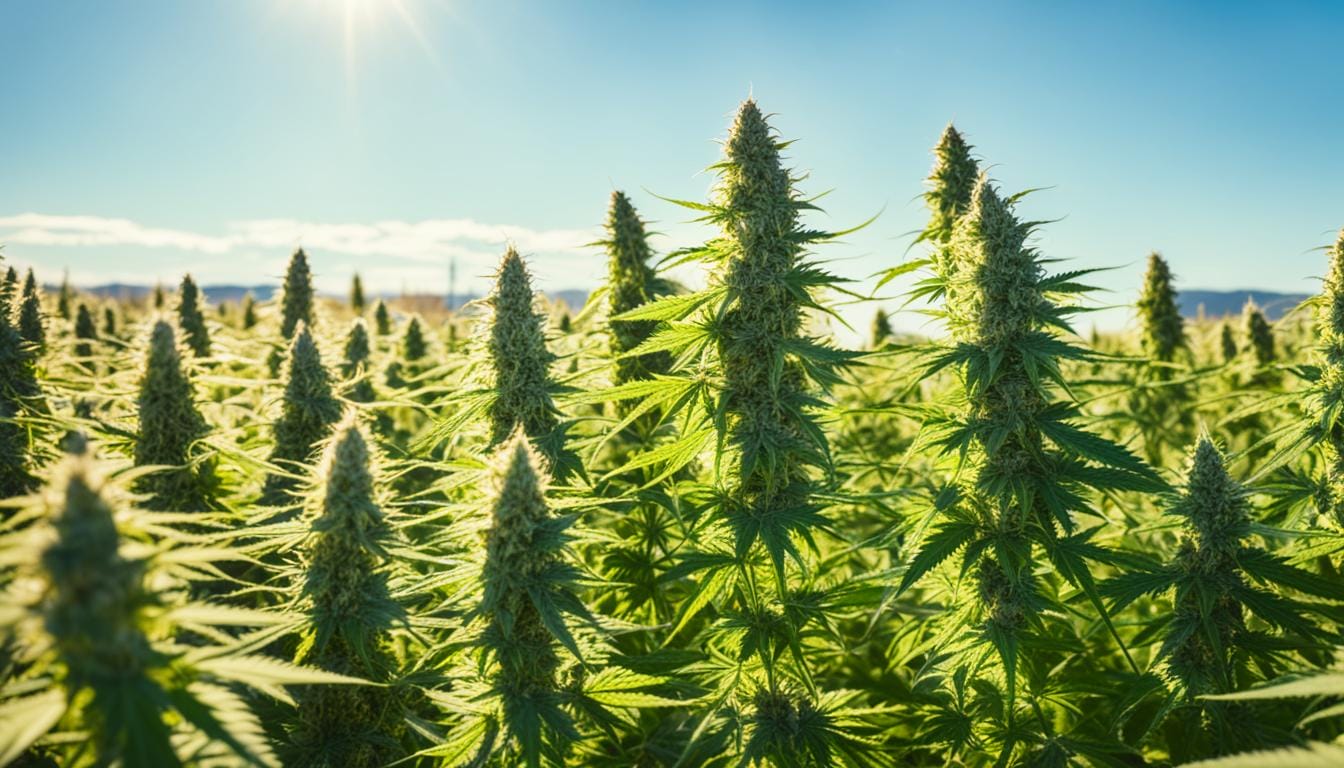Introduction to AI in Agriculture The integration of Artificial Intelligence (AI) into agriculture is no longer a futuristic concept but a transformative reality. In the realm of agriculture, AI’s potential to optimize processes, maximize yields, and sustain environmental resources is unparalleled. This is especially pertinent in specialized sectors such as cannabis cultivation, where precision and […]
Autoflower vs. Photoperiod Cannabis Seeds
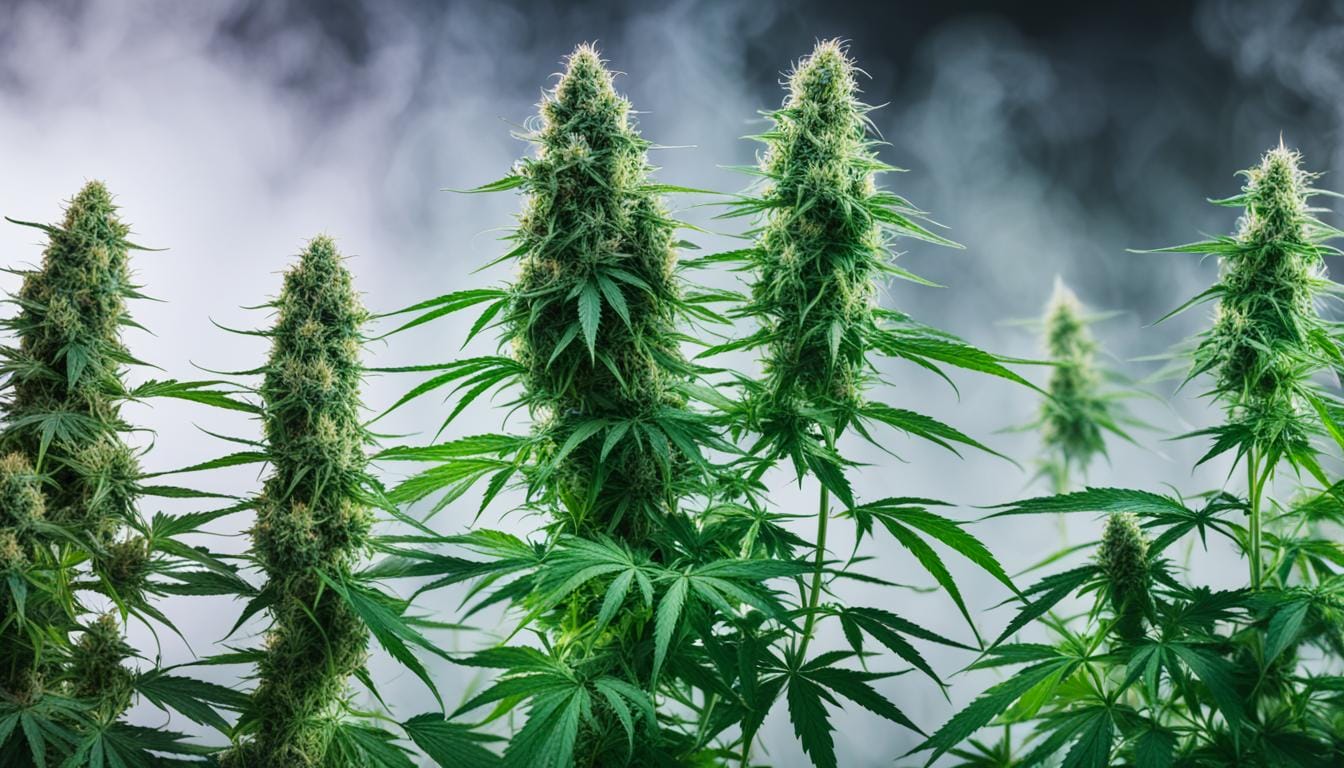
Are you curious about the key differences between autoflower and photoperiod cannabis strains? Do you want to know which type of cannabis strain is best suited for your needs? Look no further! In this comprehensive guide, we will delve into the world of autoflowering and photoperiod cannabis, exploring their growth patterns, yields, and cultivation tips. Get ready to unlock the secrets of these two popular types of cannabis strains.
What are Autoflower Cannabis Seeds?
Autoflowering cannabis strains have gained popularity among growers for their unique growth patterns and ease of cultivation. Unlike photoperiod strains, which require specific light schedules to trigger flowering, autoflower strains automatically transition from the vegetative stage to the flowering stage without strict light requirements. This makes them highly suitable for beginners and those seeking a low-maintenance option.
One of the key benefits of growing autoflower cannabis seeds is the shorter overall life cycle compared to photoperiod strains. Autoflowering plants typically complete their growth cycle within 8 to 10 weeks, allowing for faster harvests. Additionally, autoflower strains are known for their resilience and ability to withstand harsh environmental conditions, making them suitable for outdoor cultivation in various climates.
When it comes to indoor cultivation, autoflowering plants offer flexibility and convenience. Due to their compact size and rapid growth, they can be easily accommodated in limited spaces such as small tents or cabinets. Furthermore, autoflower strains do not require a separate vegetative and flowering room setup, simplifying the cultivation process and reducing the need for specialized equipment.
Autoflower cannabis strains are a game-changer for growers of all skill levels. The benefits of their automatic transition to flowering, shorter life cycle, and versatility in cultivation make them a popular choice among enthusiasts. Whether you’re a novice grower or an experienced cultivator, autoflowering cannabis strains bring convenience and rewarding results to your garden.
Understanding Photoperiod Cannabis Seeds
Photoperiod cannabis seeds are known for their unique growth patterns, relying on changes in light schedules to trigger the flowering stage. This distinct characteristic gives growers greater control over the growth cycle, allowing them to optimize yields and harvest times according to their specific needs.
When it comes to photoperiod cannabis, the flowering time is a crucial factor to consider. Different strains have varying flowering times, ranging from as short as 7 weeks to as long as 12 weeks. It’s essential to understand the flowering time of the strains you choose to cultivate to plan your grow cycle effectively and achieve the desired harvest timing.
To help you navigate the world of photoperiod cannabis strains, here are some popular varieties known for their exceptional characteristics:
| Strain | Flowering Time |
|---|---|
| 1. OG Kush | 8-9 weeks |
| 2. White Widow | 8-9 weeks |
| 3. Girl Scout Cookies | 9-10 weeks |
| 4. Blue Dream | 9-10 weeks |
| 5. Northern Lights | 7-8 weeks |
Keep in mind that the flowering times mentioned are approximate and can vary depending on various factors such as growing conditions, genetics, and the expertise of the cultivator.
By understanding the unique traits and flowering times of photoperiod cannabis strains, you can make informed decisions about which strains best align with your cultivation goals and timeline.
Growth Patterns of Autoflower Cannabis Seeds
Autoflower seeds have become increasingly popular among growers due to their unique growth patterns and shorter overall life cycles. Understanding the differences between autoflowering and photoperiod cannabis strains is crucial for determining the most suitable cultivation approach. In this section, we will compare the growth patterns of autoflower and photoperiod cannabis strains and explore the potential yields each type can offer.
Growth Patterns of Autoflowering Strains
One of the main distinctions between autoflowering and photoperiod cannabis strains lies in their growth patterns. Autoflowering strains have a predetermined life cycle, which means they transition from the vegetative stage to the flowering stage automatically, regardless of the photoperiod they are exposed to. This unique characteristic enables them to complete their life cycle faster compared to photoperiod strains.
The growth patterns of autoflowering cannabis can be summarized as follows:
| Characteristic | Autoflowering Cannabis |
|---|---|
| Life Cycle Duration | 8-12 weeks from seed to harvest |
| Vegetative Stage | 2-4 weeks |
| Flowering Stage | 4-8 weeks |
This rapid growth pattern makes autoflowering cannabis strains ideal for growers seeking quicker harvests and those with limited cultivation space. Since autoflowering strains automatically transition to the flowering stage, they are not affected by changes in light schedules. This simplifies the cultivation process and reduces the required maintenance compared to photoperiod strains.
Yield Comparison: Autoflowering vs. Photoperiod Seeds
When it comes to yield potential, it is important to consider both the size and weight of the harvest. While autoflowering cannabis strains offer faster cultivation times, their yields are generally smaller compared to photoperiod strains. However, advancements in breeding techniques have led to the development of high-yielding autoflowering varieties.
The yield comparison between autoflowering and photoperiod cannabis strains can vary depending on various factors such as genetics, growing conditions, and cultivation techniques. On average, photoperiod cannabis strains tend to yield more per plant due to their longer vegetative stage and overall larger size. However, it is essential to note that autoflowering strains can compensate for their smaller yields by allowing multiple harvests per year, thanks to their quick life cycle.
Ultimately, the choice between autoflowering and photoperiod cannabis strains will depend on individual preferences and specific cultivation goals. Next, we will explore the specifics of cultivating autoflower strains, providing valuable insights and tips for successful cultivation.
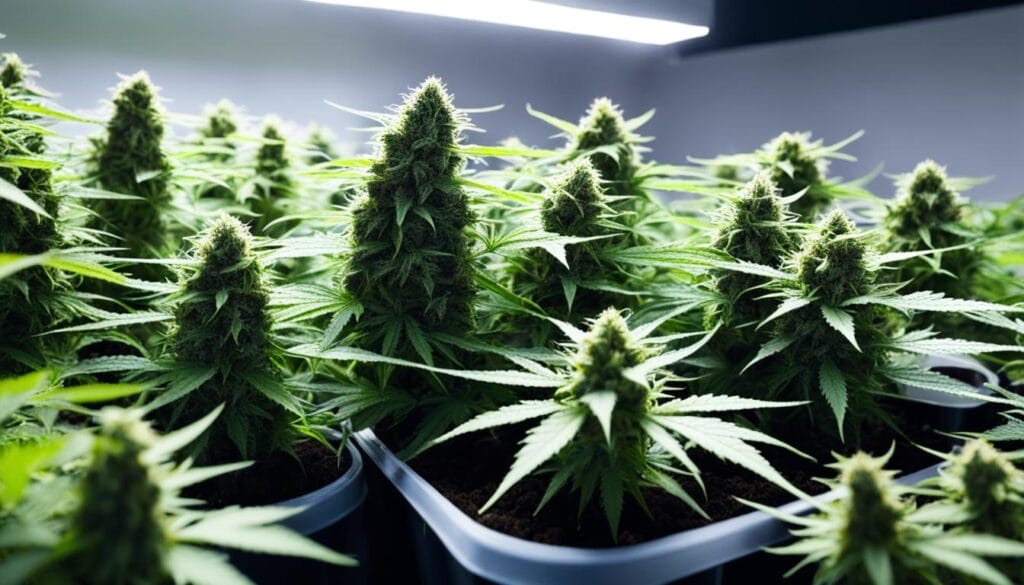
Cultivating Autoflower Strains
Whether you prefer to cultivate autoflowering cannabis indoors or outdoors, it’s important to consider the specific requirements and advantages of each approach. In this section, we will explore the pros and cons of growing autoflowering cannabis and provide valuable tips for successful cultivation, regardless of your chosen setting.
When it comes to indoor autoflower cultivation, one of the main advantages is the ability to control the environment more effectively. You have the power to manipulate factors such as light, temperature, humidity, and air circulation, optimizing the growing conditions for your plants. Additionally, indoor cultivation offers greater privacy and security, especially in areas where cannabis cultivation may be subject to legal restrictions.
However, indoor cultivation also comes with its drawbacks. It requires a greater investment in equipment, such as grow lights and ventilation systems, which can increase the overall cost of your operation. Additionally, indoor cultivation may consume more energy, resulting in higher electricity bills.
Tip: To minimize energy consumption, consider using energy-efficient LED grow lights and implementing proper insulation and ventilation techniques.
On the other hand, outdoor cultivation of autoflower cannabis has its own set of advantages. It allows for natural sunlight, offering potentially greater yields with lower energy costs and minimal investment in equipment. Outdoor cultivation also enables larger plant sizes, as plants are not confined to limited indoor spaces.
However, outdoor cultivation is subject to the changing seasons and weather conditions, which can directly impact the growth cycle and overall yield. It also poses potential challenges in terms of privacy and security, as well as susceptibility to pests and other environmental factors.
Tip: To protect your outdoor autoflowering plants from pests, consider companion planting with beneficial insect-attracting plants or implementing organic pest control methods.
Here is a summary of the pros and cons of cultivating autoflowering cannabis in different settings:
| Setting | Pros | Cons |
|---|---|---|
| Indoor | Control over environment Greater privacy and security |
Higher investment in equipment Potentially higher energy consumption |
| Outdoor | Natural sunlight Potentially larger yields Lower energy costs |
Subject to weather conditions Potential challenges with privacy and pests |
No matter which cultivation method you choose, it is crucial to provide your autoflowering cannabis plants with proper care, including optimal lighting, nutrient management, and watering techniques. Keep in mind that each strain may have specific requirements, so it’s essential to research and understand the needs of the particular autoflowering strain you are growing.
Maximizing Yields with Photoperiod Cannabis
Growing photoperiod cannabis strains gives cultivators a unique advantage in controlling the growth cycle and maximizing yields. By implementing various techniques and tips, you can optimize the cultivation process and achieve impressive results. In this section, we will explore some key strategies for maximizing photoperiod cannabis yields.
1. Proper Lighting
Lighting plays a crucial role in the growth and development of photoperiod cannabis plants. To maximize yields, it is essential to provide the right amount and type of light during each stage of growth. During the vegetative stage, use full spectrum grow lights that emit blue light to promote sturdy and healthy foliage. As the plants transition to the flowering stage, switch to lights that emit red spectrum light, as this promotes bud formation and enhanced resin production.
2. Nutrient Management
Proper nutrient management is vital for achieving optimal yields. Photoperiod cannabis strains have specific nutrient requirements at different growth stages. It is essential to monitor and maintain the right balance of macronutrients (nitrogen, phosphorus, and potassium) and micronutrients (such as iron, magnesium, and calcium) throughout the growth cycle. Consider using organic fertilizers or nutrient solutions specifically formulated for cannabis cultivation to ensure your plants receive all the necessary elements for robust growth.
3. Training Methods
Training techniques, such as topping, pruning, and using trellis systems, can significantly impact yields. These methods help create a more even plant canopy, allowing for better light penetration and distribution. Topping involves removing the main growing tip to encourage lateral bud development, resulting in multiple main colas. Pruning involves selectively removing unwanted leaves and branches to redirect energy and resources to the topmost buds. Trellis systems provide support for heavy buds, preventing branches from breaking and enhancing overall yields.
| Technique | Description | Benefits |
|---|---|---|
| Topping | Removing the main growing tip | Encourages lateral bud development and multiple main colas |
| Pruning | Selectively removing leaves and branches | Redirects energy and resources to topmost buds |
| Trellis Systems | Provides support for heavy buds | Prevents branches from breaking and enhances overall yields |
Remember, it is crucial to understand each technique and apply them with care. Proper timing and technique execution can make a significant difference in your overall yields.
By implementing these techniques and properly managing lighting and nutrient requirements, you can maximize yields when cultivating photoperiod cannabis strains. Always monitor your plants closely, adjust your techniques as needed, and ensure optimal conditions for healthy growth. The ultimate goal is to achieve robust buds with high THC levels, outstanding terpene profiles, and impressive overall yields.
Choosing the Right Cannabis Seeds for Your Needs
When it comes to selecting the perfect cannabis strain, understanding your specific needs and preferences is crucial. Whether you’re a seasoned grower or just starting out, considering the advantages of both autoflowering and photoperiod strains is essential. By taking into account factors such as time constraints, growing experience, and desired effects, you can make an informed decision that aligns with your goals.
The Advantages of Autoflowering Cannabis Strains
Autoflowering cannabis strains offer several distinct advantages that are worth considering. One of the main benefits is their ability to automatically transition from the vegetative stage to the flowering stage, regardless of light cycle. This means you don’t need to worry about adjusting your lighting schedule, making autoflowering strains a convenient choice for beginners or those looking for a low-maintenance option.
Additionally, autoflowering strains tend to have a shorter overall life cycle compared to photoperiod strains. This means they can be harvested sooner, allowing for faster turnaround times. Furthermore, autoflowering strains are often more compact in size, making them ideal for growers with limited space.
The Advantages of Photoperiod Cannabis Strains
On the other hand, photoperiod cannabis strains offer unique advantages that may be appealing to experienced growers. One key advantage is the ability to have greater control over the growth cycle by manipulating light schedules. This control allows growers to optimize yields, harvest times, and even the overall potency of the plants.
Photoperiod strains also tend to have larger yields compared to autoflowering strains. This is because the longer growth cycle and larger overall size of photoperiod plants allow for greater biomass production. Additionally, photoperiod strains often have more diverse and potent cannabinoid profiles, allowing for a wider range of effects and flavors.
| Autoflower Seeds | Photoperiod Seeds |
|---|---|
| Shorter life cycle | Requires specific light schedules |
| Compact size, suitable for small spaces | May require separate vegetative and flowering rooms |
| Low-maintenance, minimal care required | May require more attention and care |
| Can thrive in various environments | Requires optimal conditions for growth |
| Resilient to pests, diseases, and stressors | May be more vulnerable to pests and diseases |
Choosing the Perfect Cannabis Strain
When it comes to choosing the right cannabis strain, it’s important to consider the following factors:
- Your time constraints: If you’re looking for a quick harvest and a shorter overall growth cycle, autoflowering strains may be the best option.
- Your growing experience: If you’re an experienced grower who wants more control over the growth cycle and higher yields, photoperiod strains may be the better choice.
- Your desired effects: Consider the cannabinoid profile and desired effects of the strain you’re interested in. This will help ensure you select a strain that aligns with your preferences.
By considering these factors, you can narrow down your options and find the perfect cannabis strain that suits your needs.
Remember, whether you choose an autoflowering or photoperiod strain, both offer unique advantages and can be cultivated successfully with the right knowledge and techniques.
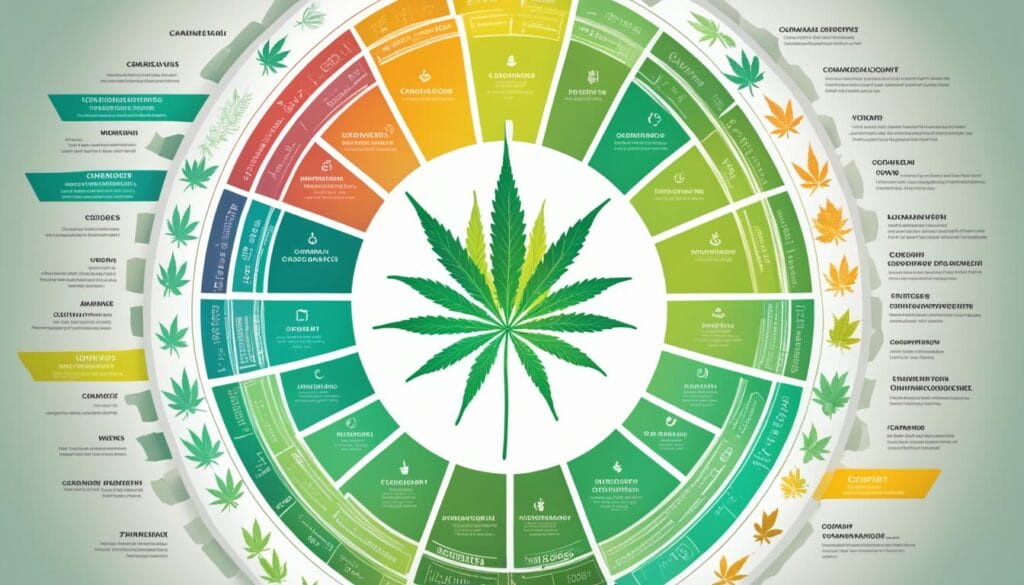
| Advantages of Autoflowering Strains | Advantages of Photoperiod Strains |
|---|---|
| Automatic transition to flowering stage | Greater control over growth cycle |
| Shorter overall life cycle | Larger yields |
| Convenient for beginners | Diverse cannabinoid profiles |
Tips for Successful Cannabis Cultivation
Regardless of the cannabis strain you choose to grow, there are general cultivation tips and practices that can help ensure a successful harvest. By following these tips, you can maximize the growth potential of your cannabis plants and avoid common mistakes that can hinder their development.
1. Provide Proper Lighting
Lighting plays a crucial role in cannabis cultivation. Whether you are growing indoors or outdoors, it is essential to provide your plants with the right amount and type of light. For indoor cultivation, consider using high-quality LED grow lights or HID lights to mimic natural sunlight. Outdoor growers should position their plants in areas that receive ample sunlight throughout the day.
2. Water Wisely
Proper watering is another key factor in successful cannabis cultivation. Overwatering can lead to root rot and other issues, while underwatering can stunt growth and reduce yields. Ensure that your plants receive enough water to keep the soil moist but not waterlogged. Use a moisture meter or observe the plants’ leaves for signs of dehydration to determine the right watering schedule.
3. Implement Proper Nutrient Management
Cannabis plants require a balance of essential nutrients to thrive. It’s important to understand the nutritional needs of your chosen strain and provide the appropriate fertilizers or additives accordingly. Consider using organic nutrients to promote healthier plant growth and enhance the flavor and aroma of your harvested buds.
4. Control Pest and Disease Issues
Pests and diseases can wreak havoc on your cannabis plants if left unchecked. Implement preventive measures such as regular inspections, proper sanitation, and the use of organic insecticides or fungicides when necessary. Identifying and addressing pest or disease issues early on can save your plants from significant damage and potential crop loss.
5. Prune and Train your Plants
Pruning and training techniques can help optimize yields and create a more efficient use of space. Regularly remove any dead or damaged foliage to promote better airflow and prevent the spread of diseases. Consider using techniques such as topping, FIMing, or low-stress training (LST) to encourage bushier growth and increase the number of bud sites.
Remember, each cannabis strain may have specific cultivation requirements, so it’s essential to research and understand the needs of your chosen strain. By following these general tips and adapting them to your specific circumstances, you can cultivate healthy and productive cannabis plants.
Understanding the Legalities of Cannabis Cultivation
Before embarking on cannabis cultivation, it is essential to understand the legalities surrounding it. This section provides an overview of the legal considerations for cannabis cultivation, particularly focusing on the laws and regulations in the United States. It is crucial to navigate the legal landscape and ensure compliance with applicable regulations to avoid legal consequences.
Legal Considerations for Cannabis Cultivation
- Federal Laws: Cannabis is still classified as a Schedule I substance under federal law, making it illegal for cultivation, distribution, and consumption. However, individual states have implemented their own cannabis laws, creating a complex legal environment.
- State Laws: Each state has its own set of laws regarding cannabis cultivation. Some states allow both recreational and medical cannabis cultivation, while others have strict regulations or prohibit it completely. It is important to familiarize yourself with the specific laws in your state.
- Licensing: Many states require individuals or businesses to obtain a license to cultivate cannabis legally. These licenses often come with specific requirements and regulations, such as background checks, security measures, and compliance with cultivation limits.
- Local Zoning Laws: In addition to state laws, local zoning laws may dictate where cannabis cultivation is permitted. Some areas have restrictions on cultivating cannabis near schools, residential areas, or sensitive locations.
- Compliance: To ensure compliance with cannabis cultivation laws, it is crucial to stay informed about any updates or changes in the legal landscape. Regularly review state and local laws, comply with licensing requirements, and consult legal professionals or industry organizations for guidance.
Understanding and abiding by the legal considerations for cannabis cultivation is essential for anyone interested in growing cannabis. Ignorance of the law is not a valid defense, so it’s crucial to research and comply with the laws and regulations in your jurisdiction to ensure a safe and legal cultivation experience.
Remember: laws regarding cannabis cultivation can vary greatly between states and even within different jurisdictions. Stay informed and consult legal professionals to navigate the legal landscape effectively.
Autoflower vs. Photoperiod Cannabis Seeds: Conclusion
The choice between autoflowering and photoperiod cannabis strains ultimately depends on your specific needs, preferences, and growing circumstances.
Understanding the key differences and considering factors such as growth patterns, yields, and cultivation requirements will help you make an informed decision.
Whether you opt for the simplicity of autoflowering strains or the control offered by photoperiod strains, SeedsHereNow.com is here to provide you with high-quality cannabis seeds and expert guidance throughout your cultivation journey.
Now that you understand the differences between autoflower and photoperiod strains, shop the collection of regular, feminized, and autoflower cannabis seeds at Seeds Here Now.
FAQs
What are the differences between autoflowering and photoperiod cannabis strains?
What are the benefits of growing autoflowering cannabis?
How do photoperiod cannabis strains differ from autoflowering strains in terms of flowering time?
What are some popular photoperiod cannabis strains?
How does the growth pattern of autoflowering cannabis differ from photoperiod cannabis?
What yield can I expect from autoflowering and photoperiod cannabis strains?
What are the pros and cons of growing autoflowering cannabis?
Can I grow autoflowering cannabis indoors and outdoors?
How can I maximize yields when growing photoperiod cannabis?
What factors should I consider when choosing between autoflowering and photoperiod cannabis strains?
What tips can you provide for successful cannabis cultivation?
What legal considerations should I be aware of when cultivating cannabis?
Back


